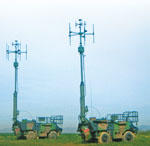Jammers Transmit Battlefield Flexibility
Equipment, software capability can listen to or interfere with signals on land or sea. 
The Q family of communications intelligence and electronic warfare systems features subgroups devoted to land, naval and intelligence applications. Land Q is a set of electronic attack and support applications. Among the systems available to Land Q is a vehicle-mounted antenna capable of intercepting and analyzing or jamming commercial or military communications networks.
Armed forces around the world soon may deploy an integrated family of communications intelligence and electronic warfare systems. Designed for export, the hardware and software supports land and sea forces, as well as national intelligence services, by sharing data across all echelons from the tactical level up to national-level organizations. Parts of the system already are in service with the French army.
Unveiled earlier this year, the Q series offers an intelligence gathering and electronic warfare capability packaged in a set of interoperable software and hardware. Developed and manufactured by the Thales Group’s Land and Joint Systems Division,
The entire Q series and its three subsets are now entering service, says Valery Rousset, director of Thales’ command, control, communications, computers, intelligence, surveillance and reconnaissance (C4ISR) marketing and capability development, command and intelligence unit,
Land Q consists of a set of tactical electronic support and attack applications that can be provided as equipment, systems and services. It is a dedicated communications intelligence (COMINT)/electronic support measures (ESM)/electronic countermeasures (ECM) mission package designed to counter communications during air-land operations. Capable of operating in a range of operations from peacekeeping to open warfare, Land Q can monitor and counter a variety of battlefield communications in the high frequency (HF), very high frequency (VHF) and ultrahigh frequency (UHF) bands operating in fixed-frequency or frequency-agile modes.
The land package can include sensor payloads, sensor exploitation hardware and software, and sensor integration on platforms such as shelters, ground vehicles, unmanned aerial vehicles (UAVs) and light aircraft. Additionally, Land Q can be integrated into secure voice and data networks operating on combat net radios. Software applications include a variety of technical and tactical functions such as sensor planning and tasking; sensor and post-sensor exploitation such as surveillance, interception, direction finding (DF), monitoring and signal analysis; intelligence production and dissemination; and multisource data fusion.
One of the platforms is an electronic support vehicle that is currently providing French army units with signals intelligence. The wheeled vehicle features a deployable mast antenna designed to collect radar and communications bands. “You’re catching all the networks,” Rousset says.
He adds that the vehicle is designed for analyzing very dense networks in both civilian and military spectrum bands. The vehicle houses two SIGINT operators who can reconfigure their workstation interfaces for individual mission requirements. A user-defined interface also allows operators to subscribe to the systems they need at the time. “If you don’t have any radars on the battlefield, which is usually the case, the two operators will focus on COMINT. If they don’t have the time, they will just focus on interception and direction finding. If they have the time, they will do technical analysis and work out the content of the communications,” he says.
The system’s operators also can record data and reach back to higher echelons or headquarters where technical analysts can examine the signal. “But you’re still in a conventional warfare context,” Rousset explains.
Land Q equipment is designed to support a range of missions. One example is a manportable, inflatable VHF/UHF antenna for special forces units, known as light electronic reconnaissance teams in the French army. The antenna is housed in a backpack with the inflatable section folding back into the container-backpack frame. Another soldier operates and carries the antenna’s payload, which is the interception and direction-finding system. Rousset notes that it is the same size and volume as a Thales PR4G tactical radio.
The inflatable antenna serves as a direction finder. The backpack unit can locate a range of military and commercial bands such as Global System Mobile transmissions. Rousset shares that the system is very simple to operate. The antenna can be manually inflated, and the entire system can be ready for operation within five minutes, he says.
The backpack system also enables warfighters to conduct signal interception on the move. It permits operators to detect transmissions by their angle of arrival. A handheld computer automatically classifies the signal’s type and frequency. Rousset explains that the handheld computer features a waveform library to aid with signal detection.
Operators also can conduct direction finding on the halt. By deploying the antenna, they can locate the signal’s source. He adds that signal interception also can take place on the move. Rousset notes that Thales already has placed three different orders with customers and that police forces have used the device. He adds that in urban terrain, the backpack unit can be deployed from the top of a building. The system can detect and classify personal radios, cellular telephones and tactical radios. “It doesn’t have the processing capability of large battlefield network interception, but it’s dedicated to local tactical use,” he says.
Naval Q is similar to Land Q in that it offers a range of tactical electronic support applications that can be installed in shore facilities, maritime patrol aircraft or aboard military vessels. Naval Q is based on Thales’ experience with sensor subsystems and sensor integration for maritime platforms. The company’s latest generation of digital wideband sensor systems is in service on European Horizon-class air defense frigates, Lafayette-class frigates and on the new FREMM multimission frigates.
Littoral environments present a challenging radio frequency environment because of the close proximity to shore-based communications. Company officials note that the ability to monitor land network traffic makes counter-ESM (CESM) and COMINT missions attractive in littoral areas. However, reaction time is shorter, and CESM-based data must often be correlated with other sensor input. To meet these needs, Thales designed its Naval Q components to be standardized and to operate open architecture software.
The system includes new integrated, network-enabled tactical consoles designed to reduce crew requirements and to facilitate CESM data distribution among a ship’s subsystems. Fast signal interception and DF capabilities allow data to be managed by functions such as alert CESM, which automatically displays, classifies and positions threats. It also can survey multiple channels individually. Shared situational awareness data collected from a naval tactical Internet can be displayed on a maritime C4I system to augment local situational awareness in littoral areas. An automated information system (AIS) interface provides collaborative identification and tracking of surrounding surface tracks. AIS information can be combined with interferometry and DF to determine broadcast information, providing littoral surveillance platforms with passive detection and tracking of surface targets.
Intelligence Q is designed to provide national and joint users with a range of strategic intelligence gathering capabilities. It is intended to meet national needs for homeland defense, border monitoring and national security. Intelligence Q provides multi-user information exploitation and dissemination. It can integrate COMINT assets on fixed or mobile platforms, and it can assimilate with electronic intelligence to form a signals intelligence capability that includes sensor, sensor exploitation and COMINT production. Intelligence Q also can meet needs for operation center integration, secure communications, all-source data fusion, and sensor-command and control integration.
This intelligence capability is managed by highly automated interception and exploitation systems. Thales officials note that the company’s newest sensors are software-defined digital devices capable of combining signal digitization, wideband exploitation, automated extraction, recognition and classification of technical parameters, multichannel monitoring and recording. The new sensors also feature computer-aided tools for technical and operational exploitation that include threat library management. Other capabilities include elaborating and disseminating reports or studying electronic enemy orders of battle.
The electronic warfare component of Q is built around the TRC 274, which is part of the company’s latest generation of digitized jammers. Rousset notes that the jammer can be installed on a range of platforms such as UAVs, ground stations or armored personnel carriers. “Our jamming concept is ESM inside ECM. All our jammers have interception capabilities and signal analysis built in so that they can generate the right waveform. It’s not blind jamming. We call it smart or responsive jamming. It’s responsive because we know the threat, and we respond to this specific threat, not jamming the whole band,” he says.
This targeted jamming capability allows the system to conduct “spot” jamming on small sub-bands to enable friendly ground forces to keep operating. He notes that in operations such as counter-improvised explosive device (IED) missions, blanket jamming causes many difficulties. “We are inserting the jamming at very specific points,” he says.
Rousset adds that Thales UK has developed a library of threat emissions that can be detected and jammed. This electronic library can be downloaded into the TRC 274 and updated on a daily basis to keep up with an evolving threat. He explains that such flexibility is necessary, especially in the counter-IED mission, because insurgents can switch between cellular telephones to garage door openers as trigger devices.
Web Resource
Thales Group: www.thalesgroup.com


